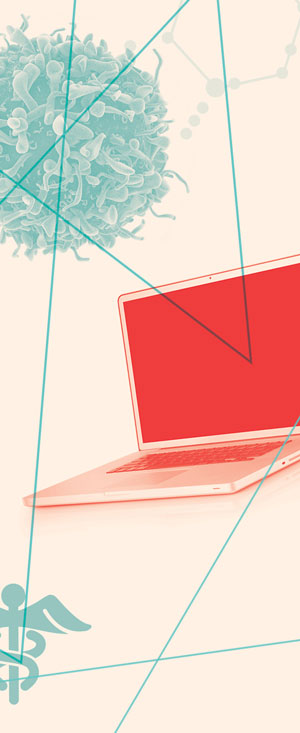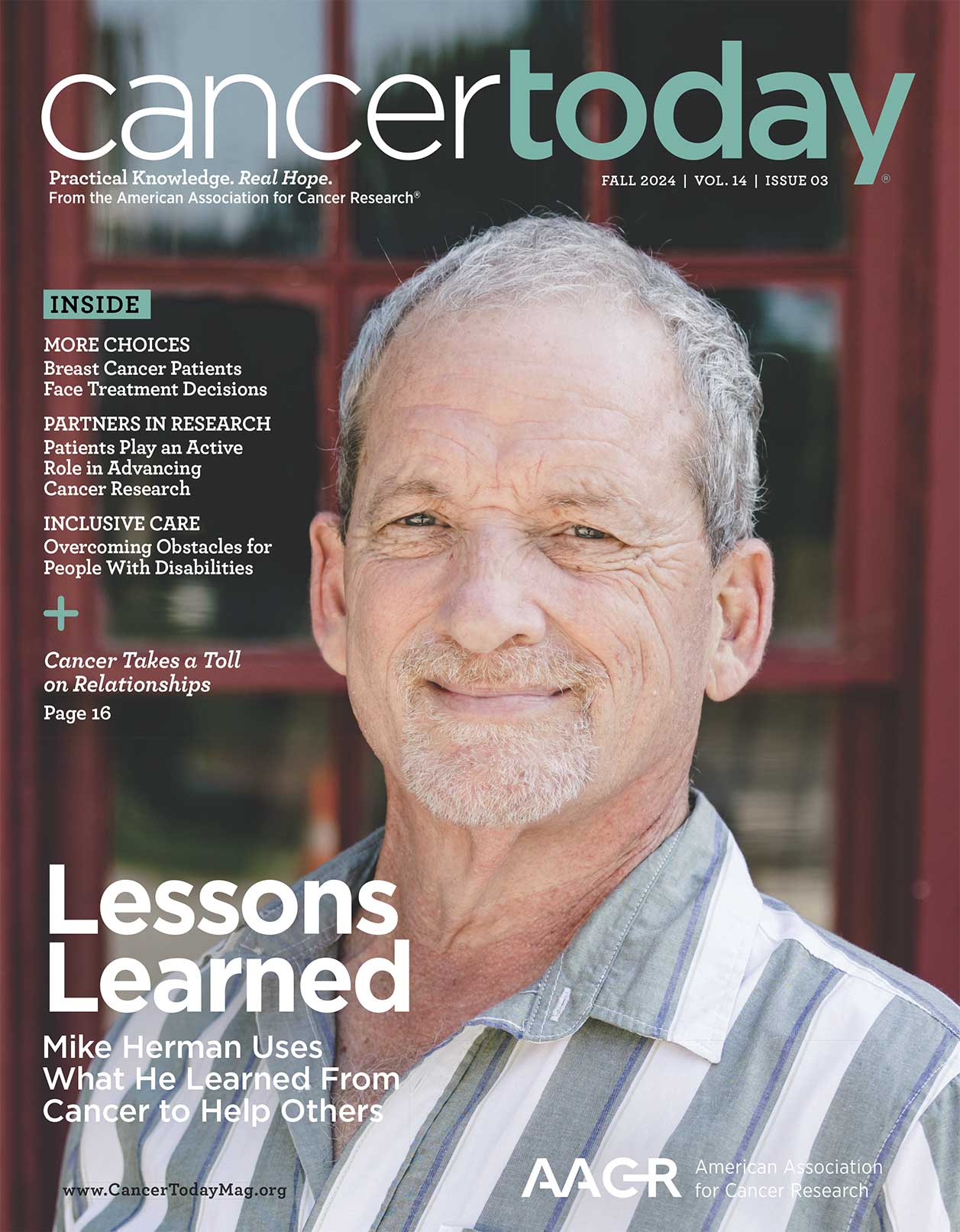In June 2014, oncologist Fabrice Denis of the Jean Bernard Center, a cancer hospital in Le Mans, France, began approaching people diagnosed with advanced lung cancer whose disease hadn’t progressed after initial treatment. He wanted them to try an unconventional approach to health care. It didn’t involve a new drug, a combination therapy or an experimental test of an emerging technology. It was much simpler. Patients would use a web-based application to report on their condition and symptoms, and they’d have regular email access to an oncologist.
Denis wanted to study patient-reported outcomes, or PROs—experiences reported directly by people via surveys, web apps or other instruments rather than filtered through health care providers. Participants would agree to a less frequent regimen of routine follow-up CT scans, the normal way to look for cancer recurrence. (They would receive scans when their self-reported symptoms indicated the disease might be growing again.) Denis thought limiting routine scans would make the study a hard sell, but he was wrong. Within 18 months, the study was filled; 133 people with advanced lung cancer from five cancer centers in France had signed on. As it turned out, he says, “it was very easy to find patients.”
The study’s findings, published in 2017 in the Journal of the National Cancer Institute, were startling. After two years of follow-up, Denis and his group found that patients who reported their symptoms via the online tool survived, on average, seven months longer than patients receiving the usual care in the form of regular screenings. He attributes the benefit to earlier detection and treatment of relapses.

For new approaches to cancer treatment, seven months of additional survival is a long time. Successful and expensive targeted drugs often fail to deliver that kind of benefit. In a recent phase III clinical trial, for example, the targeted drug Zelboraf (vemurafenib) extended survival in people with metastatic melanoma who had a particular genetic mutation by about four months, compared with patients treated with chemotherapy.
Denis’ study, and others like it, are exploring the role and effectiveness of PROs. These emerging findings suggest that integrating patient experiences into health records and treatment recommendations can improve communication and possibly even prognosis. “The role of patients in their own care is changing,” Denis says. “PROs lead to early supportive care, early detection of events and the earliest treatment of relapse. You accumulate overall survival and quality of life.”
Interest in PROs has bloomed among advocates, clinicians, researchers and patients. They are increasingly being used in clinical trials to monitor participants’ symptoms. PROs can help clinicians identify symptoms they would otherwise miss, and that knowledge can inform treatment decisions, according to recent studies. The National Institutes of Health (NIH) has funded the development of new ways to measure patients’ experiences, and the National Cancer Institute’s Cancer Moonshot has awarded grants to researchers hammering out ways to collect, interpret and use PRO data.
Oncologist Ethan Basch of the University of North Carolina’s Lineberger Cancer Center in Chapel Hill is a researcher looking for ways to optimize PROs to improve cancer care. He is excited by the growing interest among researchers and advocates in finding new ways to listen to patients. “There’s a lot of momentum in the field, and I think [using PROs] will truly improve the patient experience,” he says.
Learning to Listen
At a doctor’s visit or during a clinical trial, outcomes are typically reported and recorded in several different ways. A clinician may ask a patient questions about his or her condition and record the responses. Blood draws, scans and other tests can measure the body’s response to cancer or its treatment.
“But some problems don’t have a blood test,” says psychologist David Victorson of Northwestern University’s Feinberg School of Medicine in Chicago. No biomarkers exist that accurately reveal a person’s depression, fatigue or level of pain, for example. A survey given during an exam may not capture the full range or depth of a patient’s symptoms.
“As opposed to an objective measure like tumor cell count or white blood cell count, a PRO allows a patient or their advocate to express to their provider what they are experiencing and what’s important to them in cancer care,” says Kevin Stein, executive director of the Research and Training Institute at the Cancer Support Community (CSC), a patient advocacy nonprofit based in Washington, D.C.
Historically, says Victorson, the scientific community has dismissed attempts to quantify the patient experience. He says it seemed too nebulous and “soft”: How could a person’s description of symptoms translate into usable data? Patients were seen as too unreliable, he says. “One person’s report of a 10 on a pain scale might be the same as another one’s report of a 3.”
But in recent years, that perspective has changed, according to Victorson. Researchers have developed rigorous new tools and mathematical models that can integrate self-reported symptoms with more conventional outcomes. Those new tools include PROMIS (Patient-Reported Outcomes Measurement Information System), a project funded by the NIH and led, with other experts, by psychologist David Cella, also at the Feinberg School of Medicine in Chicago. PROMIS collects and quantifies data directly from patients on PROs, including pain, emotional distress, fatigue and other factors that can affect quality of life.

“We’ve realized that we do need to trust and make sure that we fully incorporate the voice of the patient,” says Victorson, who is currently involved in studies aimed at validating and improving PROMIS.
The increased attention on patients’ reports represents a nuanced view of cancer that goes beyond basic statistics. “In the not-too-distant past, when we would do studies of outcomes in cancer, all the information was looked at objectively,” Stein says. “How far has a tumor progressed? How many people have died? How long have they survived?” Now, he says, patients are asked about their values and how cancer has an impact on their lives.
Basch says patient-centeredness has become more important in medicine, not only in cancer care, in the past 10 or 15 years. That’s partly because of advances in technology that have led to new ways of reaching patients. He also credits advocacy groups that have brought attention to the importance of including patient voices. Furthermore, he says researchers have only recently appreciated the clinical value of the symptoms doctors have been missing.
And they’ve been missing a lot. Studies suggest that patients with cancer and other conditions have physical symptoms that go unreported to their doctors about half the time. That means what a patient feels may not match what goes into the health records, which are used to determine treatment. But those symptoms could provide important insights into a patient’s condition, and “that information can be very valuable to use in drug development and clinical care,” says Basch. For example, the U.S. Food and Drug Administration and drug developers could look at PROs to better assess a drug’s effectiveness, and prescribing information could include these insights in the future to help patients prepare for side effects and symptoms.
Missed Symptoms
Between 2007 and 2011, Basch ran a clinical trial at Memorial Sloan Kettering Cancer Center in New York City to assess patients’ responses to tools used to collect PROs. It was similar to the one that Denis would launch in France a few years later.
In Basch’s trial, more than 750 patients were divided into two groups. One received usual care, which meant symptoms were discussed during doctor’s appointments and patients could call the doctor’s office with concerns. Participants in the other group used a web-based tool on a weekly basis to rate themselves on a five-point scale on 12 specific symptoms associated with chemotherapy, including fatigue, hot flashes, nausea, pain, breathing difficulties and appetite loss. If a patient reported that a symptom had worsened, the system automatically sent an alert to a nurse, who contacted the patient to discuss the symptom and make a follow-up plan. At each visit, the providers reviewed the patient’s symptom history.
Patients who used the web-based tool felt more connected to their providers, Basch says. Communication improved too: Patients reported having better discussions during office visits. In addition, self-reporting patients visited emergency rooms less often and had fewer hospitalizations. “We were catching things early, before they became severe,” says Basch. “And these patients weren’t coming into the clinic with uncontrolled symptoms.”
As an oncologist, Basch says he wasn’t surprised that patients whose symptoms were addressed early had a better quality of life. But he was surprised by the extent of the benefit. In a follow-up analysis, he and his team found that self-reporting patients lived, on average, five months longer than those undergoing standard care. He says that’s likely because addressing symptoms early helped patients to resume chemotherapy and tolerate more of it.
Other Uses for PROs
For now, most doctors don’t have a standard way to collect PROs, and researchers are still trying to find the best way to integrate this information into electronic medical records. But there are other ways that collecting PROs and sharing those outcomes can help patients.
Breast reconstructive surgeon Andrea Pusic at Brigham and Women’s Hospital in Boston has run studies using PROs to measure patient satisfaction with different types of breast reconstruction after mastectomy. Researchers in Australia have used PROs to survey more than 600 women diagnosed with ovarian cancer about how they handle the daunting choices, aggressive treatments and difficult quality of life questions that accompany a diagnosis. The results of their survey, published in December 2018 in Supportive Care in Cancer, identified common coping strategies—including acceptance, action planning and psychosocial support like counseling—that doctors, caregivers and advocates could share with future patients.
Some advocacy organizations maintain databases where people with cancer can contribute their own voices and learn from others’ experiences. The Pancreatic Cancer Action Network (PanCAN) has a patient registry where people can share their stories, symptoms and treatment history. The CSC’s Cancer Experience Registry, which launched six years ago, includes information from more than 13,000 people.
“We have asked patients and caregivers and survivors about a wide range of issues around their cancers, including about treatment decision-making and physical, social and emotional issues,” says Stein of CSC.
The information in the registry remains confidential, and Stein says the group’s researchers use it for original research. “We can aggregate the data to look at the symptom profile associated with certain treatments,” he says. At the same time, patients can access that information to better understand what to expect from treatment.
This kind of analysis could identify treatments that are clinically effective but lead to side effects that can destabilize a person’s quality of life. A person with low-risk prostate cancer, for example, may opt for active surveillance instead of surgery to avoid the chance of side effects like incontinence. The database has also led to the development of Cancer Support Source, a distress screening tool that can help health care providers quickly identify patients who are at risk of psychological distress and advise them to seek help immediately.
Getting Involved to Benefit Patients
CSC works with investigators to find ways to integrate PROs in clinical research. But the ultimate goal, says Stein, is for the benefits to reach a broader patient population. “We need to have PROs become a standard part of both clinical practice and research,” he says. “We need to ensure that patients have that opportunity to share with providers.”
Basch sees three primary challenges to widespread integration of PROs into standard care. First is money. PROs have demonstrated a benefit to patients and “are a good thing to do and the right thing to do,” he says. But at the same time, they’re inexpensive and won’t generate revenues for hospitals, drugmakers or cancer centers. “They’re not making money for anyone,” Basch says.

Second, he says, is a technical challenge. Hospitals and clinicians are increasingly adopting electronic health record systems, not all of which integrate PROs into patient charts. Cella and Victorson at the Feinberg School of Medicine, along with dozens of researchers around the world, are developing and testing ways to make integration possible.
Third is work flow. “As doctors or nurses, we have a certain way of doing things, and there is a certain amount of resistance to change, as with anything,” Basch says. Integrating PROs into standard cancer care will require small changes in how medicine is practiced. He believes those changes will happen, but that they’ll take time to be widely implemented.
Basch thinks none of these challenges are insurmountable. In the meantime, patients who aren’t experiencing PROs as part of their care can still find ways to make sure their voices are heard, he says. In addition to patient experience databases like those run by PanCAN and CSC, patients can get involved in patient-family advocacy councils at cancer centers and hospitals. These groups enable researchers designing clinical trials and hospital administrators to hear the perspectives of patients and their families.
Patients can also ask their oncologists about clinical trials designed to test and improve the use of PROs. At the 2018 meeting of the American Society of Clinical Oncology, Denis presented findings from a follow-up study that, like his earlier one, showed improvements in quality of life and overall survival in self-reporting patients with lung cancer. He and Basch are working toward a 2019 launch of an international trial of a web-based reporting tool involving about 500 patients in the U.S., France, Australia and Canada.
“We will include all cancer types—good prognosis and bad prognosis, all stages, with all therapies,” says Denis. They want to know how PROs can affect a larger population. By the end of 2019, he hopes that a web-based PRO tool will be available to providers and patients worldwide, not just those participating in clinical trials. “We know that this is the future of patient follow-up,” he says.
Cancer Today magazine is free to cancer patients, survivors and caregivers who live in the U.S. Subscribe here to receive four issues per year.





